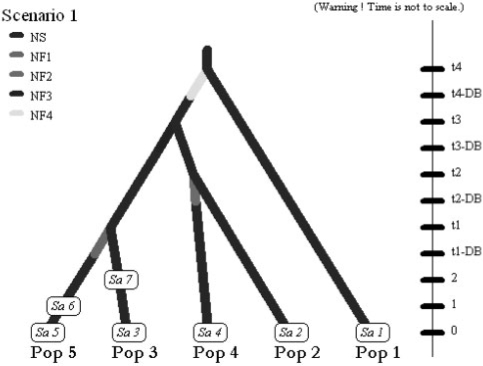Fig. 2.
Second example: screenshot of the scenario used in the analysis of the Z. lateralis lateralis dataset. In 1830, Z. l. lateralis colonized the South Island of New Zealand (Pop 2) from Tasmania (Pop 1). In the following years, the population began expanding and dispersing, and reached the North Island by 1856 (Pop 3). Chatham Island (Pop 4) was colonized in 1856 from the South Island, and Norfolk Island (Pop 5) was colonized in 1904 from the North Island (historical information reviewed in Estoup and Clegg 2003). Sample collection times are 1997 for Tasmania (Sa 1), South and North Island of New Zealand (Sa 2 and Sa 3, respectively), Chatham Island (Sa 4) and Norfolk Island (Sa 5), 1994 for the second sample from Norfolk (Sa 6), and 1992 for the second sample from the North Island of New Zealand (Sa 7). Splitting events and sampling dates in years were translated in number of generations since the most recent sampling date by assuming a generation time of 3 years (Estoup and Clegg, 2003). We hence fixed t1, t2, t3 and t4 to 31, 47, 47 and 56 generations, respectively.

